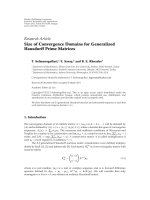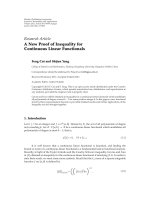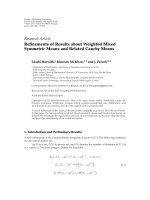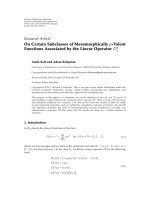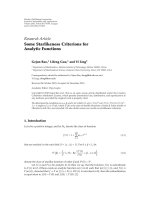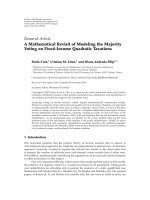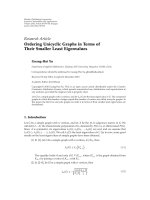CONTROLLABILITY OF ELECTROSPINNING AND ELECTROSPRAYING ADVANCES AND APPLICATION
Bạn đang xem bản rút gọn của tài liệu. Xem và tải ngay bản đầy đủ của tài liệu tại đây (3.57 MB, 146 trang )
CONTROLLABILITY OF ELECTROSPINNING AND
ELECTROSPRAYING - ADVANCES AND APPLICATION
SEBASTIAN HEINZ GERHARD NEUBERT
NATIONAL UNIVERSITY OF SINGAPORE
2010
CONTROLLABILITY OF ELECTROSPINNING AND
ELECTROSPRAYING - ADVANCES AND APPLICATION
SEBASTIAN HEINZ GERHARD NEUBERT
(Diplom-Ingenieur, TUM)
A THESIS SUBMITTED
FOR THE DEGREE OF MASTER OF ENGINEERING
DEPARTMENT OF MECHANICAL ENGINEERING
NATIONAL UNIVERSITY OF SINGAPORE
2010
II
Acknowledgements
The following research work was done in the “Healthcare and Energy Material
Laboratories” (HEM) at Nanoscience and Nanotechnology Initiative (NUSNNI) and the
Department of Mechanical Engineering at the National University of Singapore (NUS). The
author would like to acknowledge and express his utmost gratitude to his project supervisor
Prof. S. Ramakrishna, NUS Vice-President and Head of Healthcare and Energy Materials
Laboratory for his guidance, his support and the fruitful discussions.
In addition, the author thanks all lab mates for the excellent collaboration and
partnership in research. Especially, he thanks the research fellow Dr. D. Pliszka for his
mentorship, his contributions and the numerous scientific discussions. In addition, he thanks
Dr. V. Thavasi, Manager of Nanoscience – and Nanotechnology Initiative (NUSNNI), for
his cooperation and the numerous discussions with him. Besides, he would like to thank the
research fellows Dr. J. Venugopal, Dr. M. Prabhakaran and Dr. S. Sundarrajan for their help
in the experimental part of his work. Furthermore, he thanks Ing. Cand. Stefan Grott,
exchange student at NUSNNI from TUM, for his cooperation on the field of
biocompatibility testing.
The author would like to acknowledge Prof. E. Wintermantel, Professor ordinarius of
the Department and Institute of Medical Technology at TU Munich (TUM). He introduced
the author to Prof. S. Ramakrishna and therefore deserves his utmost gratitude.
The author thanks the “German Academic Foundation” as well as the Dr. Jürgen
Ulderup Foundation for their generous financial support of his stay at the National
University of Singapore (NUS).
The author has special gratitude for his family for their encouragement and support for
pursuing all endeavors.
IIII
Table of Contents
Acknowledgements
I
Table of Content
II
Summary
V
List of Scholarships and Awards
List of Tables
List of Figures
List of Symbols
1.
Introduction
VII
VIII
X
XV
1
1.1
Motivation and aim
1
1.2
Thesis structure
5
2.
Experimental techniques
7
2.1
Electrospinning
7
2.2
Electrospraying
10
2.3
Characterization
14
II
3.
Focused fibers deposition by electrospinning
3.1
Experimental details
17
17
3.1.1
Materials
17
3.1.2
Membrane fabrication
18
3.2
Results
3.2.1
3.2.2
3.3
4.
19
Electrostatic lens systems
3.2.1.1
Single ring electrode
25
3.2.1.2
Guard electrode
27
3.2.1.3
Combinations of ring and tube electrodes
27
3.2.1.4
Geometry of the electrospinning setup
29
Optimized setup
Discussion
31
34
Patterning with electrospinning
4.1
20
Experimental details
36
36
4.1.1
Materials
36
4.1.2
Membrane fabrication
37
4.1.3
Biocompatibility test
42
4.2
Results
45
4.2.1
Impact of setup design on pattern structure
45
4.2.2
Fibers morphology
63
4.2.3
Mechanical properties of the fibers structure
71
4.2.4
4.3
4.2.3.1
Elasticity
76
4.2.3.2
Tensile strength
81
Cell culturing with cardiomyocytes
Discussion
83
87
III
5.
Controllability of electrospraying
5.1
92
5.1.1
Materials
92
5.1.2
Membrane fabrication
94
5.2
Results
96
5.2.1
CSA doped PANi-PEO fibers
96
5.2.2
Effect of collectors on the adhesion of TiO2 nanoparticles
98
5.2.3
Catalytic performance of TiO2-PANi-PEO fibrous membrane
5.3
6.
Experimental details
92
Discussion
Conclusions and future perspectives
103
107
109
Appendix 1
111
Bibliography
117
IV
IV
Summary
In this thesis, methods to control electrospinning and electrospraying are presented.
Controllability of these processes is defined as the possibility of fibers deposition at a small
spot as well as the capability to pattern fibers patterns.
Electrospinning of various polymers is focused by modifying the electric field with
electrostatic lens systems consisting of additional ring, guard and tube electrodes to enhance
the precision of electrospinning. Fibers deposition spot size with a diameter 3-4 mm are
achieved. On moving collectors, fibers lines with a width of 0.15 ± 0.013 mm are fabricated.
Additional electrodes are also found to be useful to control the pore size of electrospun fibers
membranes.
To control the polymer electrospinning jet for patterning, switchable steering
electrodes are introduced into the standard electrospinning setup. They are charged at a
defined frequency with high voltage. Due to the switchable charging of the steering
electrodes, the electrospinning polymer jet is set into a state of controllable oscillation.
Control over the movement of the polymer jet in one direction is gained with one pair of
steering electrodes. In one dimension, the polymer jet is controlled at the maximum over a
width of ~33 mm. Two dimensional control is achieved with two pairs of steering electrodes
acting perpendicular to each other. Square patterns with a size ~13 mm were achieved. The
impact of the process parameters like frequency of the voltage signal, the voltage applied at
the steering electrodes or by the geometric dimensions of the steering electrodes on the
geometric dimensions of the patterns is shown. With defined fibers orientation, the
mechanical properties are made more controllable with this method.
With the help of the steering electrodes, not only the fibers structure could be
determined and modified, but also the fibers morphology. A buckling fibers morphology is
observed for electrospinning. The combination of buckling structure and fibers patterns
improves the elasticity of the fibrous membrane from an E-modulus ~19 MPa for random
V
fibers structure to ~2 MPa for patterns fibers with buckling morphology and does not affect
the tensile strength. The E-modulus is further reduced to ~1 MPa by exposure to cell culture
medium in order to model the cell culturing conditions for the fibrous membranes.
The mechanical properties are discussed for application in cardiac tissue engineering.
Electrospraying deposition is controlled by attracting the dispersed droplets on a
nanostructured conductive collector. Controllability of droplet deposition at nanoscale is
shown for electrospraying. The resulting composite structure is evaluated for photocatalytic
application.
Controlled electrospraying is used for coating a porous fibrous membrane with
photocatalytic TiO2 nanoparticles. Besides the investigation of the fabrication mechanism,
the mechanical stability and the photocatalytic activity are studied. This membrane combines
the function of detoxification as well as filtration and therefore contributes to the protection
of human health.
The developed methods to enhance controllability of electrospinning and
electrospraying are tested for applications to protect and recover human health. The
electrospun patterned fibers structures with buckling morphology are investigated to evaluate
their potential for application as cardiac tissue engineering patch scaffold to recover
myocardial
infarction.
Besides
the
structural,
morphological
and
mechanical
characterization, the biocompatibility of the membranes was tested with cardiomyocytes.
IV
VI
List of Scholarships and Awards
1. Fellowship of the German Academic Foundation
(Studienstiftung des deutschen Volkes)
2. Scholarship funded by the Dr. Juergen Ulderup Foundation for Master of
Engineering Program at the National University of Singapore (NUS)
Conference contributions
1. „Precise Patterning by Electrospinning – A Novel Tool for Tissue Engineering“
D. Pliszka, S. Neubert, S. Grott, S. Ramakrishna
MRS-S Trilateral Conference on Advances in Nanoscience:
Energy, Water and Healthcare, Aug. 11-13, Singapore
VII
List of Tables
Table 1.
Impact of ring electrode position with d = 33 mm on the fibers spot size and
fibers diameter.
Table 2.
Impact of varying position of the guard electrode on the spot size and the fiber
quality. PVC solution A was electrospun with a flow rate 1.0 ml/h.
Table 3.
Correlation between the elements of the electrostatic lens system, their
combination, the applied voltages V1 and V2 and the fibers spot diameter. For
all configurations, PVC solution A, a flow rate 1.0 ml/h and D = 100 mm were
applied.
Table 4.
Impact of the distance D between the spinneret tip and the collector on the fibers
spot size. For all configurations, PVC composition A and a flow rate 1.0 ml/h
were applied.
Table 5.
Nylon, PLACL and PVC fibers were electrospun with D = 70 mm and a flow
rate 1.0 ml/h. Components of the electrostatic lens system: guard electrode with
d = 50 mm positioned at x = -10 mm, ring electrode 1 with d = 25 mm
positioned at x = 1 mm and ring electrode 2 with d = 30 mm and positioned at
x = 17 mm.
Table 6.
Pattern width Wp fabricated with one pair of steering electrodes on a moving
collector (V1 = 11.8 kV; V2 = 11.5 kV; W = 12.5 mm; xI = 5 mm; xII = 20 mm;
a = 50 mm). With increasing frequency of the voltage signal f, the pattern width
decreased.
Table 7.
Pattern width fabricated with two pairs of flat steering electrodes (V1 = 11.8 kV;
V2 = 11.5 kV; W = 6.25 mm; x = 15 mm; a = 50 mm). With increasing
frequency f of the voltage signal the geometric dimensions of the fibers patters
(length Lp and width Wp) were decreased.
Table 8.
Pattern width fabricated with two pairs of circular steering electrodes
(V1 = 11.8 kV; V2 = 11.5 kV; W = 12.5 mm; x = 10 mm). Increasing voltage
signal frequency f and increasing diameter of the circular electrodes resulted in
smaller fibers patterns (length Lp and width Wp).
Table 9.
Effect of plasma treatment on the fibers diameter and the hydrophilic
characteristics of random and aligned PLACL fibers.
VIII
Table 10.
E-modulus without DMEM
Table 11.
E-modulus after 15 days exposure to DMEM.
Table 12.
The E-modulus in AP direction of membranes fabricated with one pair of
steering electrodes (V1 = 11.8 kV; W = 12.5 mm; xI = 5 mm; xII = 20 mm;
a = 50 mm). f and V2 were the varied parameters. The E-modulus was compared
with the maximum slope (Formula 7) of the function approximating the fibers
wave pattern numerically (Formula 6).
Table 13.
Tensile strength of the PLACL membranes with different structures and
morphologies; non-plasma treated (N), and plasma treated (P) without DMEM
exposure and after 15 days of DMEM exposure.
Table 14.
The tensile strength in AP direction (AP: perpendicular to fibers wave direction)
of membranes fabricated with one pair of steering electrodes (V1 = 11.8 kV;
W = 12.5 mm; xI = 5 mm; xII = 20 mm; a = 50 mm). f and V2 were the varied
parameters. The E-modulus was compared with the maximum slope (Formula 7)
of the sine function approximating the wave pattern numerically (Formula 6).
Table 15.
Composition of electrospun CSA/PANi-PEO solutions.
IXV
List of Figures
Figure 1.
Structure of the thesis.
Figure 2.
The polymer fiber is stretched from the spinneret tip on its way to the collector
a) Schematic drawing of standard electrospinning setup and electrospinning, and
b) photography of polymer jet during electrospinning.
Figure 3.
For electrospraying, the solution breaks up into droplets directly at the needle tip
and are dispersed.
Figure 4.
Modes of electrospraying (Jaworek and Sobczyk, 2008).
Figure 5.
The droplet size distribution of droplets close to the needle tip for
electrospraying of solution of 5% (w/v) TiO2 nanoparticles concentration and an
electrospraying voltage of 6 kV (Pliszka et al. (2008)).
Figure 6.
Gold electrode with a 5 µm distance on silica substrate.
Figure 7.
Setup for electrospinning of polymer fibers with electrostatic lens system.
Figure 8.
Equipotential lines in the spinneret - focusing ring - collector system:
a) ring at x = -15 mm, b) ring at x = 0 mm, and c) ring at x = 10 mm with
voltage 25 kV.
Figure 9.
Pore sizes without any additional electrode, with additional ring electrode
(x = -15 mm) and with additional ring electrode (x = 0 mm) for Nylon, PCL,
PLACL, and PVC.
Figure 10. Fibers electrospun under optimized conditions (Table 5) with flow rate 1.0 ml/h
and D = 70 mm on a static collector. Components of the electrostatic lens
system: guard electrode with d = 50 mm positioned at x = -10 mm, ring
electrode 1 with d = 25 mm positioned at x = 1 mm and ring electrode 2 with
d = 30 mm and positioned at x = 17 mm a) modelling, b) fibers spot size (PVC
solution B), c) morphology of PVC solution B, and d) morphology of Nylon
fibers.
X
Figure 11. PLACL fibers electrospun under optimized conditions (Table 5) with a flow rate
1.0 ml/h and D = 70 mm on a collector moving with ~0.1 m/s. Components of
the electrostatic lens system: guard electrode with d = 50 mm positioned at
x = -10 mm, ring electrode 1 with d = 25 mm positioned at x = 1 mm and ring
electrode 2 with d = 30 mm and positioned at x = 17 mm. The fibers line had a
width of 0.158 ± 0.013 mm.
Figure 12. Setup with one steering electrode pair. The distance between one pair of steering
electrodes was denoted as a. The collector moved in line with the steering
electrodes with a speed v.
Figure 13. Setup with two steering electrode pairs using a) flat electrodes design, and
b) circular electrodes design.
Figure 14. Principle of the electro-mechanical controller.
Figure 15. Voltage signal provided by the electro-mechanical controller. At all four
channels A, B, C and D, the same voltage signal was provided shifted by 0.5 π,
π and 1.5 π to the reference voltage signal (Channel A).
Figure 16. Electronic principle of the steering electrodes. The controller (Figure 14)
provided the RC-circuit consisting of a condensator and resistor with a defined
voltage signal. The condensator and the resistor represent the electric field and
the resistance Rtot between one steering electrode and the grounded collector
respectively.
Figure 17. Design 1: For Rtot → ∞, the expected voltage signal remwith the steering
electrodes remaining charged (qualitative estimation).
Figure 18. Design 2: For Rtot = 150 MΩ – 300 MΩ, the expected voltage signal provided by
the mechanical controller (qualitative estimation).
Figure 19. Single jet PLACL fiber extracted from the spinneret tip a) without steering
electrodes (V1 = 11.8 kV), and b) with one pair of flat steering electrodes
(V1 = 11.8 kV; V2 = 11.5 kV; W = 12.5 mm; x1 = 5 mm; x1I = 20 mm;
a = 50 mm).
Figure 20. Distance between steering electrodes a) a = 50 mm, b) a = 75 mm and
c) a = 100 mm with the following constant parameters ( V1 = 11.8 kV;
V2 = 11.5 kV; W = 12.5 mm; x = 10 mm).
XI
VI
Figure 21. Voltage applied at the steering electrodes a) V2 = 7.5 kV, b) V2 = 9.5 kV,
c) V2 = 11.5 kV and d) V2 = 13.5 kV with the following constant parameters
(V1 = 11.8 kV; W = 12.5 mm; a = 50 mm; x = 10 mm).
Figure 22. The wave fibers structure fabricated with a one pair of steering electrodes and a
moving collector was described by the period length (lp) and the pattern width
(Wp). Within this study, AP indicated the direction perpendicular to the wave
structure and AA the direction in line with the wave structure.
Figure 23. Electrospinning was controlled by two pairs of electrodes with the electrodes A
and C as well as B and D being charged in phase. A linear diagonal pattern was
fabricated with two pairs of electrodes (V1 = 11.8 kV; V2 = 11.5 kV;
W = 6.25 mm; a = 50 mm; x = 15 mm).
Figure 24. Fibers morphology of a) random fibers (V1=11.8 kV), b) fibers aligned by
deposition on rotating drum (V1=11.8 kV), and c) wave structured fibers with
buckling morphology fabricated with one pair of steering electrodes.
(V1 = 11.8 kV; V2 = 11.5 kV; W = 12.5 mm; xI = 5 mm; xII = 20 mm).
Figure 25. Buckling fibers morphology achieved for fibers controlled with one steering
electrode pair or two steering electrode pairs a) buckling structure, and b)
overview SEM image (V1 = 11.8 kV; V2 = 11.5 kV; W = 12.5 mm; xI = 5 mm;
xII = 20 mm).
Figure 26. Impact of plasma treatment on the fibers morphology a) random PLACL fibers
before plasma treatment, and b) random plasma fibers after plasma treatment.
Figure 27. Effect of plasma treatment on the pore size of a) random PLACL fibrous
membrane, b) aligned PLACL fibrous membrane collected on a rotating drum,
c) PLACL fibrous membrane deposited with one steering electrode pair, and
d) PLACL fibrous membrane deposited with two steering electrode pairs.
Figure 28. Stress (σ)-strain (ε) curves of random fibers structure fabricated with a
V1 = 11.8 kV (Same scale for all σ- ε curves).
Figure 29. Stress (σ)-strain (ε) curves of wave structure fabricated with one pair of flat
steering electrodes at the following electrospinning conditions:
W = 12.5 mm; V1 = 11.8 kV; V2 = 11.5 kV; xI = 5 mm; xII = 20 mm;
a = 50 mm; f = 50 min-1. These conditions were applied for the fabrication or
wave structure fibers within the mechanical studied if not differently stated.
Measurement in a) in AA direction, and b) in AP direction.
XII
VII
Figure 30. Stress (σ)-strain (ε) curves of square structure membranes fabricated with two
pairs of flat steering electrodes at the following electrospinning conditions:
W = 6.25 mm; V1 = 11.8 kV; V2 = 11.5 kV; x = 15 mm; a = 50 mm;
f = 50 min-1. These conditions were applied for the fabrication or square
structure fibers within the mechanical studied if not differently stated.
Figure 31. MTS assay for CM proliferation on TCP on PLACL fibrous membranes with
random structure and wave structure with one pair of steering electrodes under
standard conditions, after a) 5 days, b) 10 days, and c) 15 days of cell culturing.
Figure 32. Morphology of CMs after 10 days of cell culturing a) TCP, b) PLACL fibers
without plasma treatment, and c) PLACL fibers with plasma treatment as
substrate. After 15 days of cell culturing d) TCP, e) PLACL fibers without
plasma treatment, and f) PLACL fibers with plasma treated fibrous substrate.
Figure 33. SEM images of CMs cultured for a) 10 days on plasma treated random PLACL
fibers, b) 10 days on plasma treated PLACL fibers with wave structure,
c) 15 days on non-plasma treated random PLACL fibers.
Figure 34. Structure of polymers and dopant used in this study.
Figure 35. Setup for a) electrospinning, and b) electrospraying.
Figure 36. PEO fibers with a) 6% PANi concentration, b) 12% PANi concentration, and
c) 19% PANi concentration.
Figure 37. I-V curves of PEO fibers with a) 6% PANi concentration, b) 12% PANi
concentration, and c) 19% PANi concentration.
Figure 38. PANi-PEO fibers a) 6% of PANi and aluminum foil as the collector, b) 12% of
PANi and aluminum foil as the collector, c) 6% of PANi collected without
aluminium foil, and d) 12% of PANi collected without aluminum foil.
Figure 39. Grounded PVC fibers a) without DMF/THF residual and without aluminum
foil, b) with DMF/THF residuals and with aluminum foil, and c) with
DMF/THF residuals and without aluminum foil.
Figure 40. Schematic explanation on the electric field distribution between the spinneret tip
and conductive PANi-PEO fibers in the presence of a) no aluminum foil
beneath, and b) with aluminum foil.
Figure 41. SEM image of 12.5% PANi-PEO fibers coated with TiO2 nanoparticles (5 min
of deposition) followed by sonication of the membrane.
XIII
VIII
Figure 42. UV spectrum of CEPS in heptane at concentration of 0.05‰ (v/v).
Figure 43. UV spectra for a) 6% TiO2-PANi-PEO membranes after 0 min and 60 min UV
light exposure, and b) 12% TiO2-PANi-PEO membranes after 0 min and 60 min
UV light exposure.
Figure 44. Photocatalytic decomposition of CEPS with respect to reaction time and TiO2
quantity a), after 60 min UV light exposure, and b) 10 min UV light exposure.
Figure 45. Proposed photocatalytic action of TiO2 nanoparticles towards CEPS under UV
environment.
Figure 46. Application of the cardiac patch at the heart (Chen et al., 2008b) a) epicardial,
and b) endoventricular heart patches.
Figure 47. Helix shape of the heart muscle. Therefore, the state of stress within the heart
muscle is complex and multidirectional forces are induced into the muscle
(Buckberg, 2002). To demonstrate the complex helix shape of the heart muscle,
it is compared with the unfolding of a rope (Torrent-Guasp et al., 2001).
IX
XIV
List of Symbols
a
distance between two steering electrodes of one pair
CMs
cardiomyocytes
c
constant
D
distance between spinneret tip and collector
d
additional
E
electric field strength
F
force
f
higher voltage signal frequency
g
grams
h
hour
kV
kilo volts
LP
Square fibers pattern length
l
electrode length (applicable for all additional electrodes)
lp
period length of fibers wave pattern
mA
milliampare
min
minutes
ml
milliliter
mm
millimeter
nm
nanometer
NPs
nanoparticles
q
charge
SEM
scanning electron microscopy
t
time
UV
ultra violet
UV-VIS
ultra violet and visible
XV
V
volts; voltage
V1
electrospinning voltage between spinneret and collector
V2
voltage applied at the steering electrodes
v%
volume percentage
W
steering electrode width
Wp
fibers pattern width
w%
weight percentage
x
position of the additional electrodes
ε
strain
εE
permittivity of the space between the charges
Δ
distance between the charges
ρ
phase shift of voltage signal provided by electro-mechanical controller
σ
stress
VII
XVI
1. Introduction
1. Introduction
1.1 Motivation and aims
In present thesis, the controllability of two electro-hydrodynamic (EHD) methods,
electrospinning and electrospraying are studied.
Electrospinning is a method where a high voltage is applied to the polymer solution
drop emanating from the spinneret tip. A jet is resulted from the polymer drop, when the
applied voltage surpasses the surface tension, undergoes curling and spiraling, resulting in
the formation of fibers which are deposited on the grounded metallic collector (Reneker and
Yarin, 2008). The electrospun fibers have been used as e.g. nerve grafts, blood vessels,
wound dressings, batteries, gas, bio- and chemical sensors and catalyst (Choi et al., 2003;
Choi et al., 2004; Huang et al., 2003; Li et al., 2004). For electrospraying, ceramic solution
driven out into the electric field disperses to nanodroplets. These nanodroplets are collected
on collectors. Electrospraying is used for thin film deposition and for functional layer
formation (Jaworek et al., 2009).
With a conventional electrospinning setup, the fibers are deposited randomly on the
collector with a spot size exceeding 100 mm and usually cover the whole collector. Over the
last years, efforts have been made to make electrospinning and electrospraying a precise and
very well determined process. Most studies to improve the controllability of the fibers
deposition were based on the modification of the electric field distribution by the variation of
electrospinning process parameters and by setup modification.
For focused and therefore precise fibers deposition with electrospinning, circular or
conical auxiliary electrodes reduce the fibers spot size to 5 mm (Bellan et al., 2006; Bellan
and Craighead, 2009; Kim, 2006; Kim and Kim, 2008). Besides, the impact of a flat metal
1
1. Introduction
plate above the spinneret was studied to stabilize the polymer jet with a more uniform
electric field (Yang et al., 2008). With close distance electrospinning, a distance between the
spinneret tip and the collector of few millimeters prevented bending instability of the
polymer jet and therefore high precisions of fibers deposition were achieved (Hellmann et
al., 2009).
For one directional fibers alignment, rotating drums as collector were widely used. In
order to enhance the alignment effect, the setup was accomplished with different auxiliary
electrodes (Wu et al., 2007) and with knife-edged bars (Teo et al., 2005). In addition, the
metal plate as conventional fibers collector was replaced by sharpened electrodes (Secasanu
et al., 2009) to enhance the fibers alignment. Yang et al. (2009) applied e.g. spherical
collector shapes to achieve more uniform fibrous membranes thicknesses. In addition, one
directional fibers alignment was achieved with two parallel collector electrodes. The fibers
were stretched between the collector electrodes and therefore aligned between these (Ishii et
al., 2009; Kim, 2006; Kim and Kim, 2006; Lee et al., 2007; Yan et al., 2009; Zhang et al.,
2008). With one pair of positively charged secondary electrodes applied perpendicar to the
primary electric field, aligned fibers with a length of 10 mm were fabricated by steering the
polymer jet (Acharya et al., 2008).
An attempt for the fabrication of two dimensional fibers patterns was the collection of
electrospun fibers on patterned electrodes. Collector electrodes with ring, rectangular,
triangular openings allowed the patterning of fibers structures in two dimensions (Kim and
Kim, 2006; Li et al., 2005; Zhang et al., 2008). Furthermore, Bellan et al.(2006) reported the
controllability of electrospun fibers lines in two dimensions in a ~1 mm range with the help
of a circular steering electrodes system. It consists of four electrodes elements being charged
at a defined frequency resulting in a time varying electric field (Bellan and Craighead, 2009).
2
1. Introduction
Theoretical and numerical methods to determine the electrospinning process and its
fibers deposition have been performed (Heikkila et al., 2007; Xu, 2009).
For electrospraying, Jaworek and Krupa (1996) reported focusing with the help of
guard electrodes. Due to their small size, the charged nanodroplets dispersed easily and
therefore a defined deposition was challenging. Above studies and their results were further
discussed in context of the results of this work.
The aim of this work was to advance the controllability of the electro-hydrodynamic
(EHD) methods: electrospinning and electrospraying.
For electrospinning, the work was concentrated on two aspects:
Precise fibers deposition by focusing the electrospinning process. Focused and
precise fibers deposition is required for the breakthrough of electrospinning in mass
production of high quality products. Besides, it is a prerequisite for controlled fibers
deposition.
Patterning with electrospinning. Defined linear, square and circular fibers patterns
had to be achieved. One aspect was the maximization of the pattern dimensions.
With defined fibers structure the mechanical properties of the fibrous membrane
should be made determinable.
In this study, electrostatic lens systems were developed to achieve focused electrospinning.
Steering electrodes with time varying electric field were used to control the electrospinning
polymer jet.
For electrospraying, a more precise and uniform deposition of the dispersed
nanodroplets was the aim. The effect of conductive nanostructured collectors was studied.
In this thesis, methods to improve the controllability of electrospinning and
electrospraying were developed for applications to protect and recover human health.
3
1. Introduction
With defined fibers deposition, a fibrous scaffold could be fabricated which for
potential application as a cardiac patch. Electrospun fibrous scaffolds were widely used in
the field of tissue engineering (Ito et al., 2005; Venugopal et al., 2008) due to the fact that
fibrous scaffolds met the following requirements being important for tissue engineering:
highly porous structure scaffold with large interconnected pores to facilitate mass
transport,
hydrophilic to enhance cell adhesion,
structural stability to withstand the shearing forces during bioreactor cultivation,
biodegradability, and
non-immunogenicity.
However, for cardiac tissue engineering, the mechanical properties play a central role. Due
to complex superposition of forces in the heart muscle of different states of stress like tensile
stress, compression stress and torsion stress (Appendix 1) determinable mechanical
properties of the scaffolds were required. Therefore, fibers orientation in the electrospun
fibrous scaffold had to become more controllable. In addition, the elasticity and tensile
strength of the scaffold had to meet the values of human cardiac muscle with an E-modulus
of 0.2-0.5 MPa and a tensile strength of 3-15 kPa (Biomechanical background of these
requirements explained and discussed in Appendix 1) (Nagueh et al., 2004; Nakano et al.,
1990; Watanabe et al., 2006). However, most electrospinning approaches reported did not
meet the requirement of cardiac tissue engineering in that respect. E.g. with aligned fibers
deposited on rotating drums, defined fibers structures were achieved, but highly anisotropic
mechanical properties, too. As the cardiac muscle and therefore the cardiac patch were
exposed to multidirectional forces, such a structure was not useful for cardiac tissue
engineering.
4
1. Introduction
For electrospraying, the aim of this study was to enhance the precision of the
electrospraying droplet deposition. In this study, electrosprayed droplets were deposited on
conductive nanostructured and porous material. The nanostructured and porous collector
material was to cover with catalytic nanoparticles enhancing the activity due to the
maximized active surface area. Highly precise nanoprticles deposition was required because
the blockage of the pores with nanoparticles had to be avoided.
Controllable electrospraying was used for the fabrication of a catalytic filtration
membrane. As pollution and chemical agents have become major threats to human health,
there was a demand for nanostructures combining the function of filtration and catalysis
(Künzli et al., 2000). The function of filtration was performed by the conductive electrospun
fibrous scaffold; the catalytic activity was provided by the embedded ceramic nanoparticles.
In that way both particles could be filtered and toxic gases could be degraded.
1.2 Thesis structure
In this study, methods to enhance the controllability of two electro-hydrodynamic
methods (EHD) electrospinning and electrospraying were developed and investigated for
applications saving human lives as well as preserving human health. After motivating the
research proposed in the “Introduction” (Chap. 1), the fabrication methods electrospinning
and electrospraying as well as the applied characterization methods were presented in
“Experimental Techniques” (Chap. 2). In Chapt. 3, the methods developed for “Focused
fibers deposition by electrospinning” (Chap. 3) were presented and the impact of focusing
methods on the fibers deposition spot size, the membrane pore size and the fibers
morphology were studied. Focused electrospinning and therefore determinable fibers
deposition and orientation were the requirement for “Patterning with electrospinning” (Chap.
5
1. Introduction
4). In that way, the fibers structure as well as the fibers morphology and therefore their
mechanical properties could be influenced. The fibers structures were investigated for
potential application as cardiac tissue engineering scaffold. In Chap. 5, the “Controllability
of electrospraying” was studied. A method was developed, to control electrospraying at
nanoscale by using conductive fibers as collector. The developed membrane was studied for
application in environmental engineering like catalytic filtration applications. In Chap. 6,
“Conclusions and future perspectives” controllability of electrospinning and electrospraying
were compared and challenges for the future were identified (Figure 1).
Chap. 6
Conclusions and future perspectives
Chap. 3
Chap. 4
Chap. 5
Focusing of fibers
Patterning with
Controllability of
deposition by
electrospinning
electrospraying
3.3 Discussion
4.3 Discussion
5.3 Discussion
3.2 Results
4.2 Results
5.2 Results
3.1 Experimental
4.1 Experimental
5.1 Experimental
electrospinning
Chap. 2
Chap. 1
Figure 1.
Experimental Techniques
Introduction
Structure of the thesis.
6
2. Experimental Techniques
2. Experimental Techiques
In this chapter, the two fabrication techniques used for membrane fabrication in this
study are introduced. Both electrospinning and electrospraying are electro-hydrodynamic
methods (EHD). The setup used for both techniques is similar, however different process
conditions result in different structures. In this chapter, fundamental information about the
principle of electrospinning and electrospraying is presented. More detailed information
about the used electrospinning and electrospraying setups within this work are described in
the corresponding chapters.
2.1 Electrospinning
Electrospinning is a technique to fabricate continuous fibers with the help of an
electric field (Greiner and Wendorff, 2007). The diameter of the electrospun fibers ranges
between 10s of nm up to several µm. With electrospinning, polymers and ceramics can be
processed to fibers (Greiner and Wendorff, 2007), whereas in this study only polymer fibers
are electrospun.
Charges of different polarity result in forces of attraction. Electrospinning is based on
attraction of different polarities. For point charges, the attraction force (or repulsion in case
of same polarity) is given by Coulomb’s Law.
F
q1q2
4 E 2
(Formula 1)
When the electric field is defined as a region where a charge feels a force created by
by other charges. Its magnitude is defined by the electric field strength E.
F qE
(Formula 2)
7

